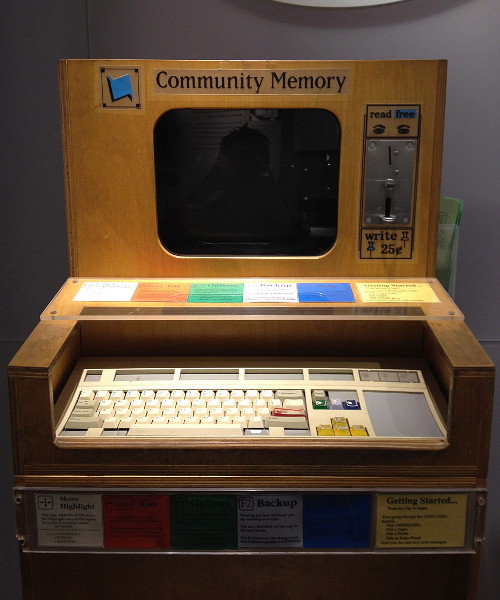
Photo by Kathryn Greenhill
I came across Community Project (CM) back in 2014 while reading a Hacker News post on Cybersyn. Half-way through the conversation was a small mention of Community Project by one of its co-founders, Mark Szpakowski.
It is, to me at least, another gem of computing history that took place between 1973 and 1975 and gave its users a glimpse of what would eventually develop into services we find today on the World Wide Web. The project demonstrated the potential of information kiosks with three noisy teletypes across the San Francisco Bay Area. The photo above shows the one located at Leopold’s Records in Berkeley. The wood casing was added to damp the noisy mechanism.
The core of the small network was powered by an XDS 940 24bit mainframe running Berkley Timesharing System as its operating system. Teletypes were connected with the mainframe using modems transmitting data via telephone lines. A new link would be established for the entire day by dialing only once. The system sustained fifty searches and ten additions per day. The cost of an XDS 940 in today’s dollars lies north of USD 750,000.
The organization providing access to such a formidable resource went by the name of Project One. Housed in an old converted candy factory, One was a commune, a high-tech pueblo hosting multiple initiatives. The SDS mainframe fell under Resource One with its team of tool makers including Lee Felsenstein, Mark Szpakowski, Efrem Lipkin, Bart Berger and John M. Cooney who aimed at creating tools for their community. One important tool aside from the hardware components was the CM software itself: ROGIRS, the Resource One General Information Retrieval System implemented in Quick Systems Programming Language. The software would let the user type keywords such as ADD to add content, FIND to search and supported logical operators such as AND, OR or NOT. As simple as tweeting wouldn’t you say?
Community Project was empowering a real-life local community in the Bay Area.
An interesting aspect behind Community Project was the explicit desire not to force a content purpose from the top down. The open information system lead CM to support data collection from people around a wide range of topics from used car sales, vacation advice to healthcare to name a few examples. It also collected opinions from people helping other folks choose between one or the other practitioner. Exclusion principles and profitability drivers had been set aside giving more freedom to the emerging uses determined by the community.
“The system is inescapably political. Its politics are concerned with people’s power - their power with respect to the information useful to them, their power with respect to the technology of information […] The system democratizes information coming and going. Whatever one’s power status in society […] one can put information into the system and take it out on an equal basis, provided its terminals are freely accessable and (relatively) free to use. It is a truly democratic and public utility, granting no one special privilege […]” - Rossman, 1975
Network effects
CM started as a tiny network with one hub and three spokes. This experiment must have inspired many people and seems so representative of the californian ideology that has spawned many more Randian heroes and entrepreneurs who evolved ROGIRS into Google, Reddit, Facebook or Twitter.
Today’s underlying infrastructure is evidently more complex. It is formed of a complex hierarchy of networks referred to as autonomous systems (or ASes) which span across geographies and organizations beyond our immediate Internet access provider, e.g. Twitter’s AS13414. We also don’t think of driving through the city to find a teletype as we have smartphones, tablets or laptops… CM has been radically scaled up.
Today, people have a vast choice of information sharing services to choose from. But today’s information highways are also very constrained. Think of that complex interconnect of AS networks carrying the small bits and bytes from content providers such Twitter, but also larger amounts for Spotify or Vimeo. Users typically pay Internet access fees to their local telecoms companies and monthly fees to content providers for audio or video which require costly equipment from AS operators. Consider also the terms and conditions accepted when signing up for the services as they usually follow for-profit business models. Infrastructure costs for online services can be as costly as the cost of that XDS mainframe.
Today the generosity of Project One has been replaced by business models which factor network effects and allow (ideally) for rapid value creation. While we amplified CM magic, we also sacrificed some of the freedom and autonomy ideals in the minds of the CM designers. Users now know that if they’re not paying for the service, they become the product. Also worth noting is that infrastructure today, in order to sustain ambitious user volumes, is distibuted across many servers and geographical regions. But logically, they still form a central database not unlike the one backing ROGIRS…
Distributed memory
CM was first an experiment local to the Bay Area. While some startups pursue rapid growth objectives and brace themselves for high investments in infrastructure to cater to the largest amount of users possible, it doesn’t have to be like that.
Considerations of decentralization and autonomy at Web scale can be complex to grasp. In addition to ASes and terminals I mentioned, are software protocols which let us resolve human readable names to machine addresses. There’s also HTTP itself which is de facto protocol used by our device’s browsers to access information from our browsers. Under the present scheme, content remains the physical property of content providers and HTTP addresses they assigned to it.
Juan Benet, author of IPFS came up with an alternative protocol which allows locating content by its fingerprint, independently of its machine address. This has implications on our ability to disseminate it in a peer-to-peer fashion in new, empowering ways.
Another hyper-local network that comes to my mind are Dead Drops. They are like digital little free libraries, a local file-sharing mechanism made of USB keys cemented into walls.

Photo by adactio
While this network of cemented keys cannot directly be compared with CM, it shares similar freedom in design when considering the sort of content that could end up on a key. As its FAQ suggests, no actions are taken to prevent viruses or malicious file drops. Just like with ROGIRS, anything goes!
Learning from the past
Community Memory made San Franisco at the time a smarter city by empowering its citizens. It’s an example of the hacker spirit that one finds today in Maker spaces and with DIY communities.
Since then, we have greatly amplified the reach and capabilities of such systems but we still have lots to learn about their ability to support self-regulating mechanisms in real-life. The feedback capability found in CM’s electronic bulletin board is not much different than that in modern online services. Allende’s original Cybersyn was based on a model which develops the notions of balancing feedback loops far beyond what we usually understand by “feedback.”
We are still apprentice sorcerers when it comes to applying network effects. These ancient projects reveal some aspects about their organization and development which help us improve today’s designs.
References
»All watched over by machines of Loving Grace«. Öffentliche Erinnerungen, demokratische Informationen und restriktive Technologien am Beispiel der »Community Memory«, Stefan Höltgen, 2014, transcript Verlag
Community Memory, Mark Szpakowski, Nov 2006, The Well
Pueblo In the City, Charles Raisch, May 1976, Mother Jones
Resource One / Community Memory, Lee Felsenstein
There Is No Internet, Lori Emerson, Apr 2014, University of Colorado at Boulder
 This material is licensed under CC BY 4.0
This material is licensed under CC BY 4.0
